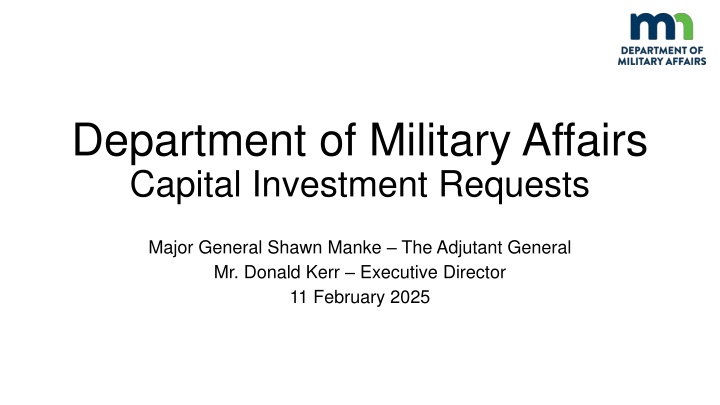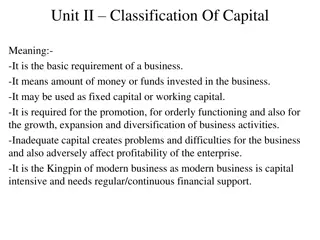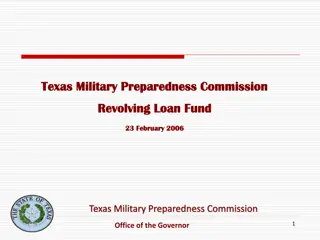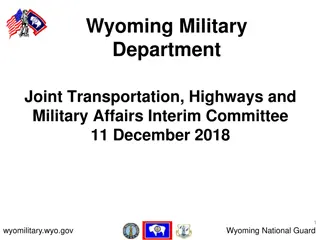
Department of Military Affairs Capital Investment Request
The Department of Military Affairs is seeking funding to design a new hangar for the 148th Fighter Wing in Duluth, equipped with modern fighter aircraft. The current hangar is outdated, posing safety risks and structural issues for both personnel and aircraft. The replacement structure must accommodate future fighter aircraft like the F-15EX and F-35, ensuring optimal functionality and safety. With a total estimated project cost of $28 million, the new hangar design will address current limitations and provide a versatile space for aircraft operations.
Uploaded on | 0 Views
Download Presentation

Please find below an Image/Link to download the presentation.
The content on the website is provided AS IS for your information and personal use only. It may not be sold, licensed, or shared on other websites without obtaining consent from the author. If you encounter any issues during the download, it is possible that the publisher has removed the file from their server.
You are allowed to download the files provided on this website for personal or commercial use, subject to the condition that they are used lawfully. All files are the property of their respective owners.
The content on the website is provided AS IS for your information and personal use only. It may not be sold, licensed, or shared on other websites without obtaining consent from the author.
E N D
Presentation Transcript
Department of Military Affairs Capital Investment Requests Major General Shawn Manke The Adjutant General Mr. Donald Kerr Executive Director 11 February 2025
148thFighter Wing Aircraft Hangar The Governor recommends $3,000,000 to design a new Universal Fighter Aircraft Hangar. The Duluth based 148th Fighter Wing is equipped with the F-16CM, the newest F-16s in the U.S. Air Force fleet. The current structure was built for the Duluth Air Force Base in 1958. It was relocated to the 148th Fighter Wing, on the northeast side of the airport in the 1980s. The current hangar was not purpose-built for modern aircraft and has significant structural and safety issues. Further, it is not capable of being used for future fighter aircraft including the F-35. The cost of the total project, which would eventually replace existing hangars, is estimated to be $28 million. Pictured above is the 75th anniversary heritage paint scheme of the 148th Fighter Wing at the 50th anniversary event of the F-16 Fighting Falcon
148th Fighter Wing Aircraft Hangar These facilities have exceeded their useful life. Water infiltrates during all seasons, creating electrical safety hazards and challenges working around the aircraft. In the winter, ice forms near the entrances, folding doorways, and between the structures. These hazards pose risks to personnel and aircraft. The lightning protection for these buildings is inadequate to protect aircraft and personnel. These facilities currently operate under a permanent waiver from the U.S. Air Force for wingtip clearance because of the inadequate size of the hangers.
148th Fighter Wing Aircraft Hangar When evaluating the design for the replacement structure, it is important to factor in the future requirements for the next generation of fighter aircraft. That may include the F-15EX, F-35, or another future fighter yet to be named. The design will include sufficient space to accommodate the width and length of potential fighters, along with any specialized equipment needed. Pictured above is an F-15EX. The F-15EX builds upon a proven airframe with modern controls, engines, radars, avionics, and weaponry. The F-15EX is the U.S. Air Force s low-cost solution to producing and quickly delivering modernized 4th generation fighters. Pictured above is the F-35, the U.S Air Force s latest fifth-generation fighter. The F-35 is an agile, versatile, high performance, 9g capable multirole fighter that combines stealth, sensor fusion and unprecedented situational awareness.
148th Fighter Wing Aircraft Hangar Three (3) bay shelter, each bay is 65 wide with 30 high doors Designed for a universal aircraft 45 wide by 64 long Design facilitates future expandability for up to eight bays Design 12-15 months Construct 18-24 months
148th Fighter Wing Aircraft Hangar Why fund a hangar? This state commitment will likely influence future decisions regarding the strategic basing of replacement fighter aircraft What is at risk? The Minnesota Air National Guard is Duluth s seventh largest employer The Minnesota National Guard provides ~$3.6M annually in fire protection services for the Duluth International Airport plus a multi- million-dollar federal investment in equipment and buildings. Loss of a flying mission would shift this burden onto the airport authority.






















